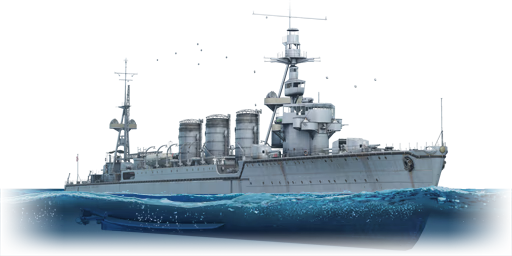



The IJN Tama (多摩, namesake: Tama River), saw eventful service during her lifetime. Commissioned shortly after World War I, her early missions included the Siberian Intervention and diplomatic duties, such as transporting the US ambassador to Japan in 1925. During the Second Sino-Japanese War, Tama conducted coastal patrols and later became part of the 5th Fleet, tasked with operations in the northern Pacific. She participated in the Aleutian Islands campaign during World War II but suffered damage from enemy action and harsh weather. In 1944, Tama was heavily damaged during the Battle off Cape Engaño, and on 25 October 1944, she was sunk by the submarine USS Jallao while attempting to withdraw, with all hands lost.
The IJN Tama was introduced in Update 1.89 "Imperial Navy" as IJN Kuma. However, due to discrepancies in the 3D model compared to the real-life vessel, she was renamed IJN Tama in the Update "Dance of Dragons", as the model more accurately matched the ship.
Tama performs best in countering enemy destroyers and poorly armoured cruisers, but she struggles against more heavily protected targets. Her broadside damage is above average, though she loses most of her firepower when engaging targets directly ahead or astern. The torpedoes have below-average warhead and low speed, but with the torpedo mode enabled, they offer exceptional range. Overall, Tama faces challenges typical of early interwar cruisers, balancing capability with limited tonnage.
| Ammunition | Type | Armor penetration (mm) at a distance: | |||||
|---|---|---|---|---|---|---|---|
| 1000 m | 2500 m | 5000 m | 7500 m | 10000 m | 15000 m | ||
| HE | 35 | 35 | 35 | 35 | 35 | 35 | |
| SAP | 86 | 75 | 59 | 46 | 37 | 35 | |
| HE-TF | 35 | 35 | 35 | 35 | 35 | 35 | |
| SAPBC | 116 | 102 | 81 | 64 | 50 | 33 | |
| Belt | Belt filling | Armor penetration (mm) at a distance: | |||||
|---|---|---|---|---|---|---|---|
| 10 m | 100 m | 500 m | 1000 m | 1500 m | 2000 m | ||
| HEF-T/HEF/AP-T/HEI | 55 | 53 | 44 | 37 | 32 | 29 | |
| AP-T/AP-T/AP-T/HEF | 55 | 53 | 44 | 37 | 32 | 29 | |
| HEF-T/HEI/HEI/HEI | 5 | 5 | 4 | 4 | 4 | 4 | |
| Belt | Belt filling | Armor penetration (mm) at a distance: | |||||
|---|---|---|---|---|---|---|---|
| 10 m | 100 m | 500 m | 1000 m | 1500 m | 2000 m | ||
| AP/T | 10 | 9 | 8 | 7 | 6 | 5 | |
10 × Type 95 depth charge
44 × Mk.6 mod1 moored contact mine











Seakeeping |
|---|
Unsinkability | |
|---|---|
Firepower | |||
|---|---|---|---|